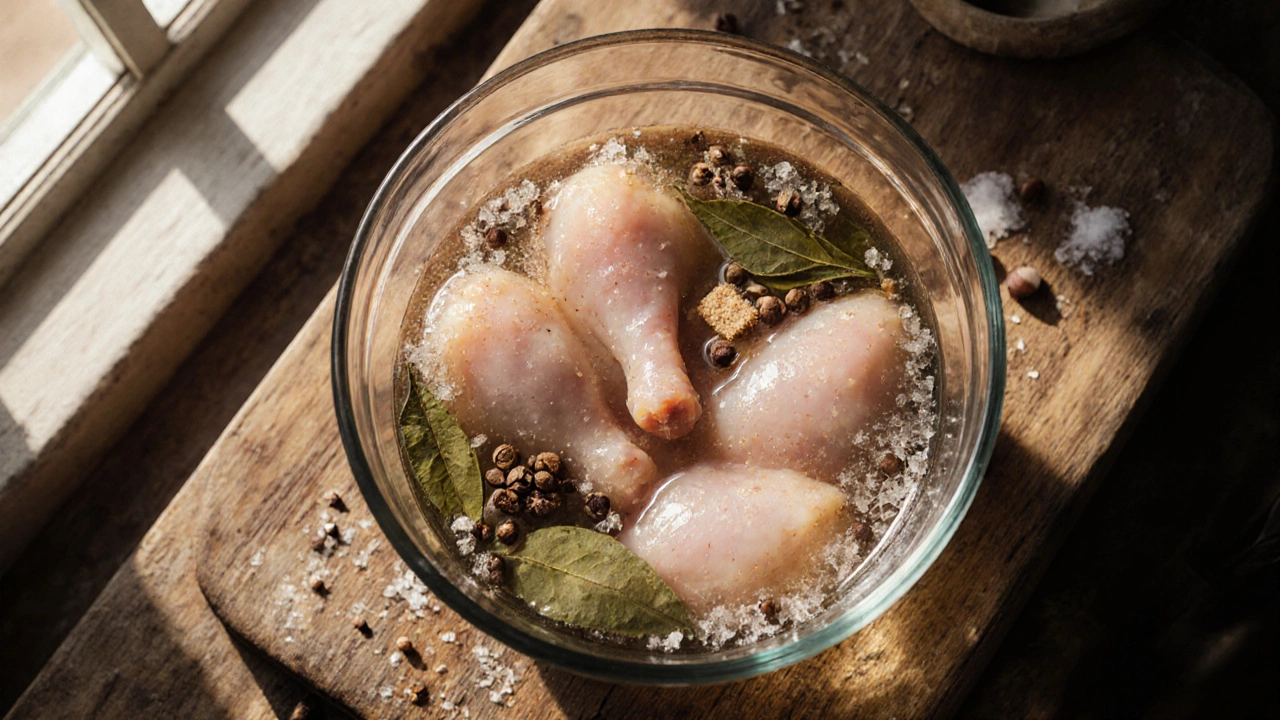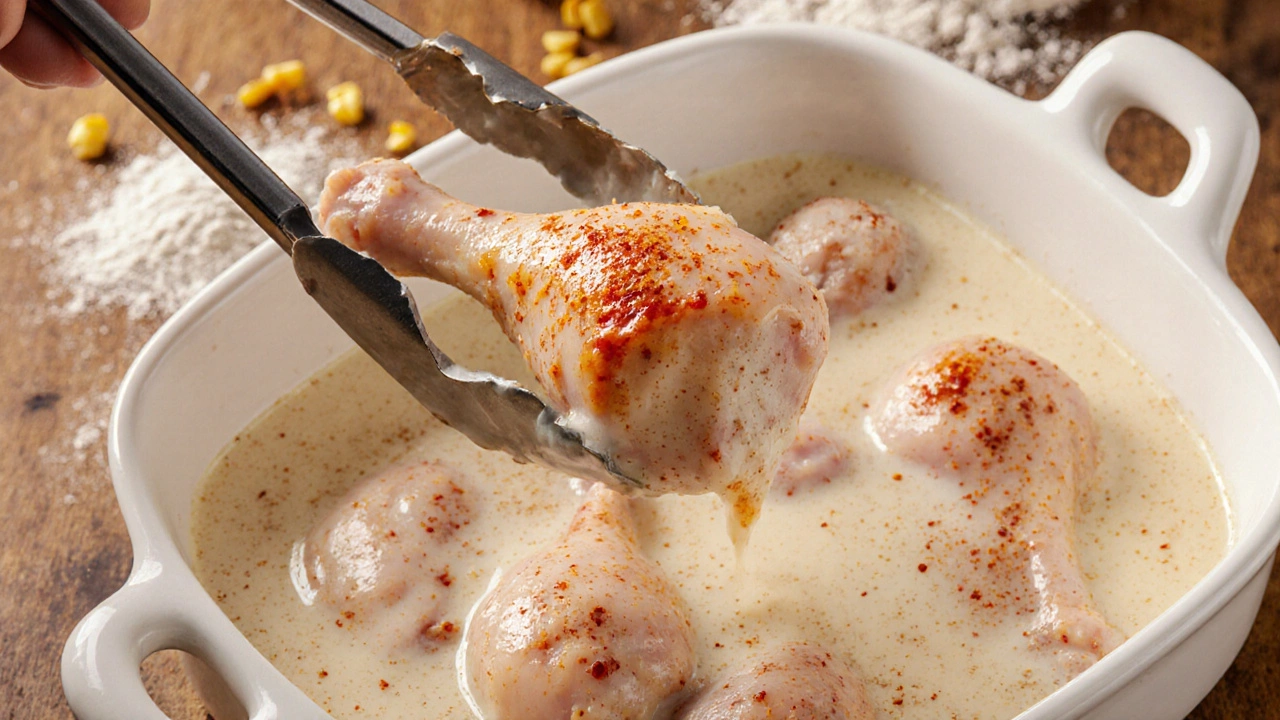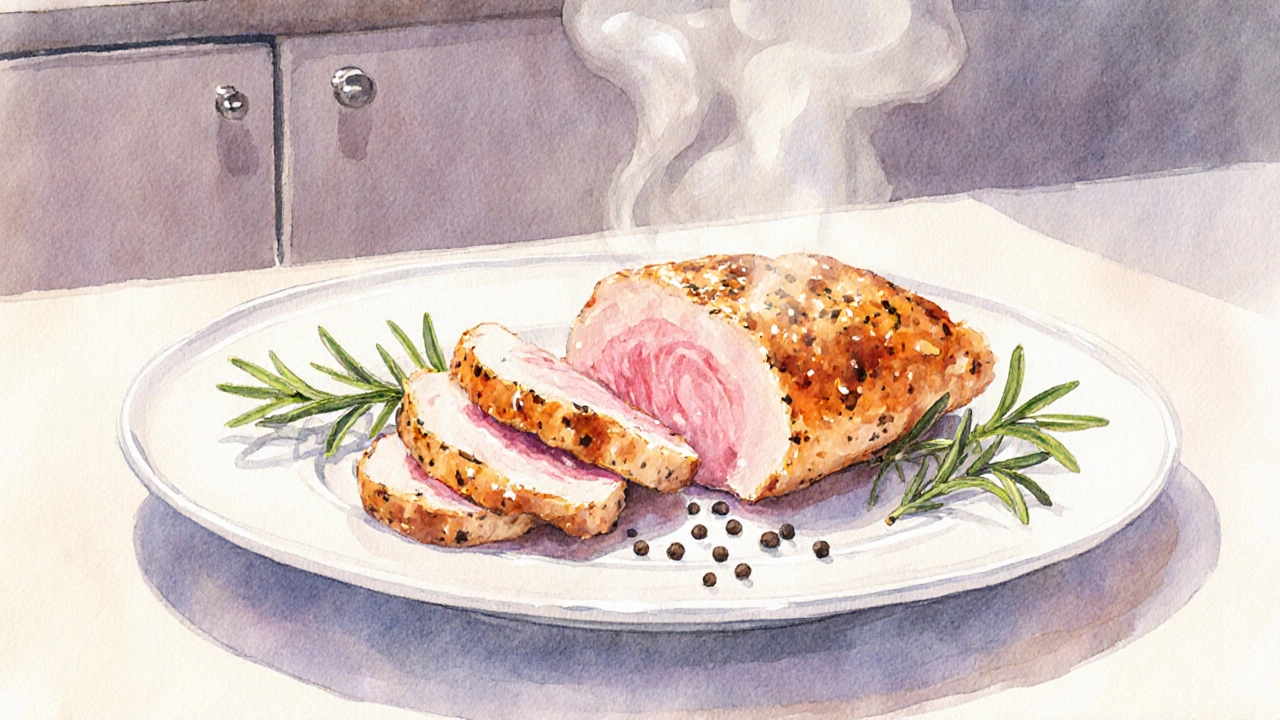Best Soaks to Make Chicken Tender - Simple Tips for Juicy Results
 Oct, 9 2025
Oct, 9 2025
Chicken Tenderizing Soak Calculator
Recommended Soak
Key Takeaways
- Brining with salt and sugar works for any cut and is great for roasting.
- Buttermilk and yogurt add mild acidity and creaminess, perfect for fried or baked chicken.
- High‑acid fruits (pineapple, papaya, lemon) act fast but can over‑tenderize if left too long.
- Combine flavor boosters-herbs, spices, aromatics-with the soak for a tasty finish.
When you want Chicken tenderizing soak a liquid mixture that breaks down muscle fibers and keeps moisture inside the meat, a few simple tricks can transform a dry piece into a juicy bite. Understanding how tender chicken is achieved lets you pick the right soak for the dish you’re planning.
Why Soaking Helps
Protein fibers are held together by collagen. Salt, acids, and enzymes each play a role in loosening those bonds:
- Salt (from brine a saline solution that diffuses into meat) draws water in through osmosis, then the meat retains it when cooked.
- Acid (from citrus juice lemon or lime juice providing citric acid or vinegar) weakens muscle proteins, making them softer.
- Enzymes (found in pineapple contains bromelain, a proteolytic enzyme or papaya contains papain, another tenderizing enzyme) actually cut protein chains.
When you combine these with a bit of sugar, fat, or dairy, the result is not just tender but also flavorful.
Top Five Soaking Liquids and How to Use Them
| Liquid | Key Tenderizing Agent | Best Cuts | Typical Soak Time |
|---|---|---|---|
| Brine | Salt + Sugar | Whole bird, breasts, thighs | 30min - 12h |
| Buttermilk | Mild Acid + Fat | Boneless breasts, nuggets | 2h - overnight |
| Yogurt | Lactic Acid + Probiotics | Leg pieces, kebabs | 3h - overnight |
| Citrus/Vinegar Marinade | Strong Acid | Thin strips, stir‑fry pieces | 15min - 1h |
| Enzymatic Fruit Juice | Proteolytic Enzymes | Small bites, tacos | 5min - 30min |
1. Classic Salt‑Sugar Brine
A basic brine uses 1cup of kosher salt and ½cup of sugar per gallon of water. Dissolve the solids, cool the solution, then submerge the chicken.
Why it works: Salt forces the muscle cells to pull in water; sugar adds flavor and slows down the protein tightening that happens during cooking.
Best practice tips:
- Refrigerate the brine; never leave at room temperature.
- For a whole bird, aim for 12h; for breast pieces, 30min to 2h is enough.
- Add aromatics-bay leaves, peppercorns, garlic-to the brine for extra depth.

2. Buttermilk Soak for Crispy Fried Chicken
Combine 2cups of buttermilk with 1tbsp of hot sauce, a pinch of salt, and a dash of paprika. Let the chicken sit for at least 2hours, preferably overnight.
Buttermilk’s lactic acid gently loosens fibers while the fat coats the surface, leading to a crisp crust after frying.
Quick tip: Pat the pieces dry before dredging in flour to avoid soggy coating.
3. Yogurt Marinade for Indian‑Style Tandoori
Mix 1cup plain full‑fat yogurt with 2tsp garam masala, 1tsp ginger‑garlic paste, and a squeeze of lemon juice. Marinate chicken thighs for 4hours to overnight.
Yogurt’s combination of acid and probiotic cultures both tenderizes and builds a flavorful crust when baked in a hot oven.
Pro tip: Add a tablespoon of mustard oil for authentic aroma and extra tenderness.
4. Citrus or Vinegar Marinade for Quick Grilling
Blend equal parts lemon juice and olive oil, add 2tbsp soy sauce, 1tsp crushed garlic, and a sprinkle of herbs. Soak thin chicken strips for 20-45minutes.
The strong acid works fast, but leaving it too long can make the meat mushy. Keep an eye on the clock.
Tip: Finish the grill on medium‑high heat; a quick sear locks in moisture.
5. Enzymatic Fruit Juice for Fast Tenderizing
Use fresh pineapple juice (or papaya puree) diluted 1:1 with water. Dip bite‑size pieces for 5-15minutes, then rinse briefly.Enzymes like bromelain break down proteins almost instantly, which is ideal for tacos or salads where you want a tender bite without a long wait.
Watch out: Over‑exposure can turn the meat into a mushy paste, so set a timer.

Choosing the Right Soak for Your Recipe
Match the soak to the cooking method and expected flavor profile:
- Roasting or baking: Brine adds moisture; yogurt adds spice.
- Stir‑fry or sauté: Citrus or quick‑acid works best because you don’t have time for long marinades.
- Deep‑fried: Buttermilk creates a protective layer for a crunchier crust.
- Grill: A balanced citrus‑soy blend gives tang and caramelization.
Common Mistakes and How to Avoid Them
1. Too much salt - A brine that’s overly salty can make the chicken itself taste salty. Stick to the 5‑6% salt‑to‑water ratio.
2. Ignoring temperature - Soaking at room temperature encourages bacterial growth. Always chill.
3. Leaving acidic mixes too long - Acid can turn the texture gummy. Use a timer.
4. Skipping the rinse - After brining, a quick rinse removes excess surface salt and prevents overly salty finished dishes.
5. Not patting dry - Moist surface hampers browning. Pat with paper towels before cooking.
Practical Step‑by‑Step Example: Oven‑Roasted Chicken Breasts
- Prepare a brine: dissolve ¾cup kosher salt and ¼cup brown sugar in 2quarts cold water. Add 2bay leaves and 4 cracked peppercorns.
- Cool the brine in the fridge for at least 30minutes.
- Submerge 4 boneless, skinless breasts. Refrigerate for 1hour.
- Remove breasts, rinse under cold water, and pat dry.
- Rub with 1tbsp olive oil, sprinkle with smoked paprika, garlic powder, and a pinch of black pepper.
- Preheat oven to 400°F (200°C). Place breasts on a rack and roast 20-25minutes, or until internal temperature hits 165°F (74°C).
- Let rest 5minutes before slicing - this locks in the juices.
The result is a juicy, tender breast that stays moist even after slicing.
Frequently Asked Questions
Can I use regular table salt for brining?
Yes, but kosher or sea salt is preferred because it dissolves evenly and doesn’t contain additives that can affect flavor.
How long can I keep chicken in a brine?
For whole birds, 12hours is safe. Smaller pieces should not exceed 4hours, or the texture will become spongy.
Is it okay to combine buttermilk and lemon juice?
Mixing a splash of lemon adds brightness, but keep the acid low (no more than 1tbsp per cup) to avoid curdling the dairy.
Do I need to season the chicken after soaking?
Yes. Soaking primarily adds moisture; a light seasoning or herb rub before cooking enhances flavor.
Can I reuse brine for another batch?
Only if you boil it first to kill any bacteria. Fresh brine is generally cheaper and ensures consistent taste.
Next Steps
Pick the soak that matches your next recipe, follow the timing guidelines, and you’ll notice a clear jump in juiciness. If you’re experimenting, start with a simple brine and add herbs or spices gradually. For quick meals, keep a small bottle of buttermilk or yogurt in the fridge - it’s a ready‑to‑use tenderizer.
Happy cooking, and enjoy that melt‑in‑your‑mouth tender chicken every time!